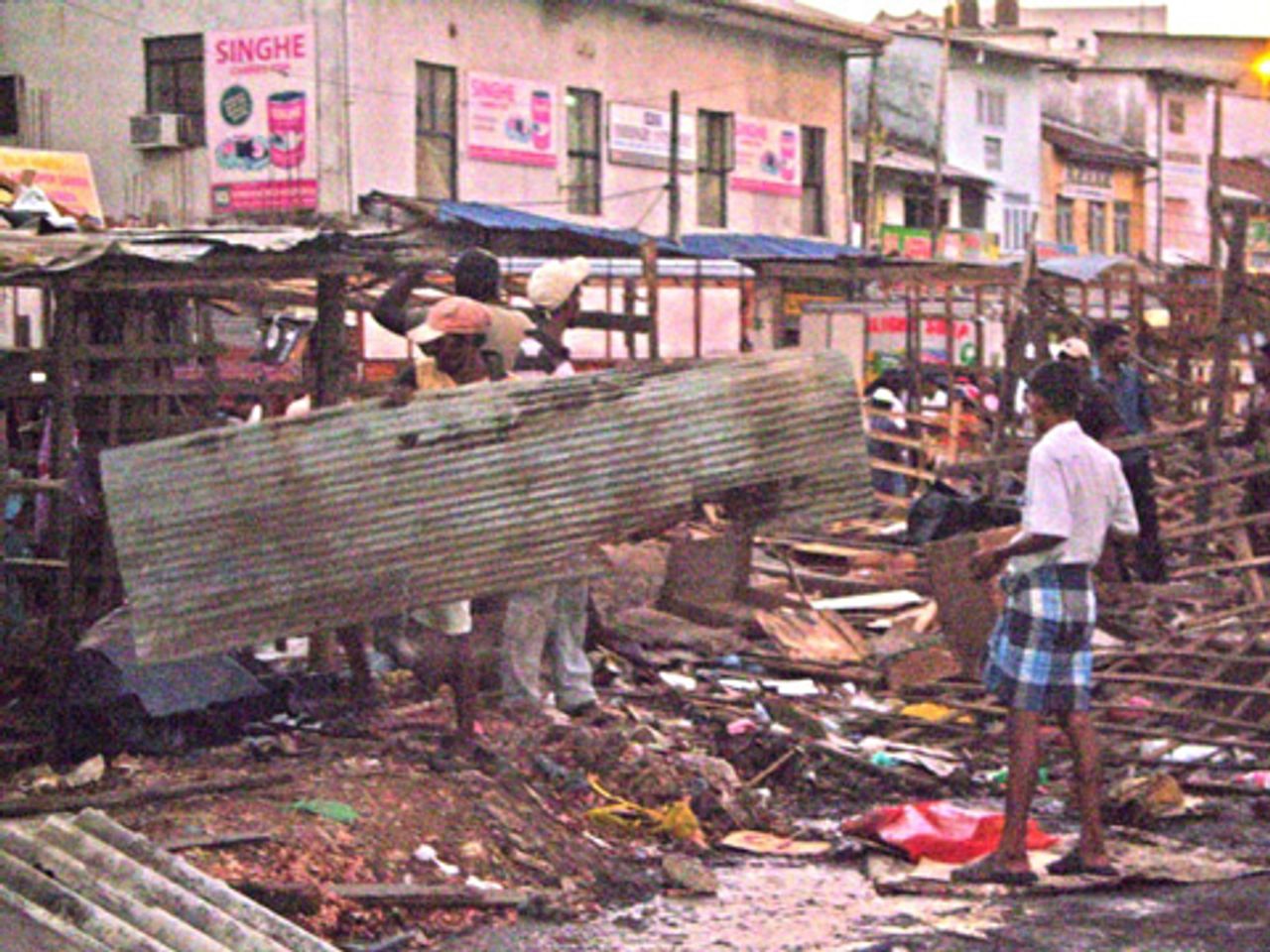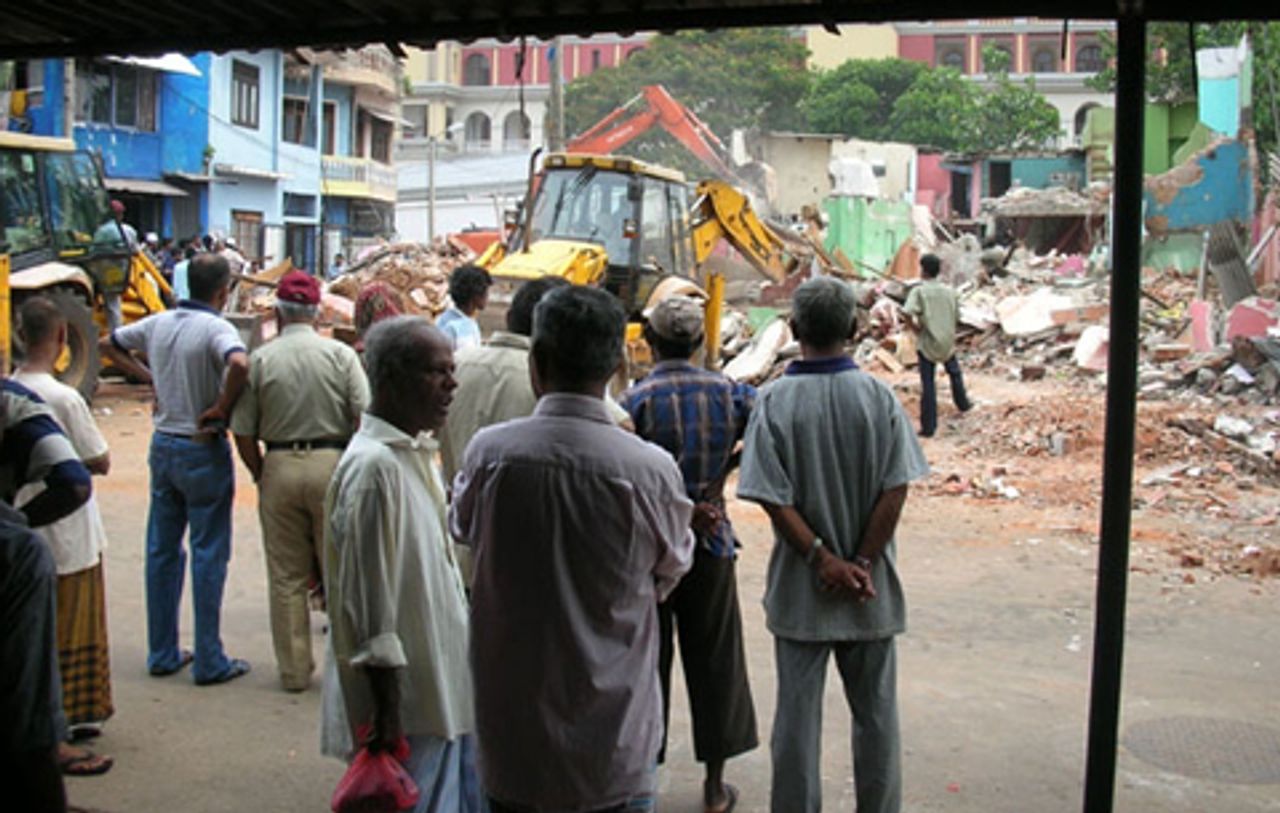Last Saturday, the Sri Lankan defence ministry deployed police and the army to evict 45 families from central Colombo and demolish their houses. Over recent days, police also have been mobilised to remove thousands of street hawkers in Colombo and its suburbs, in Kandy in the central hills and in the southern city of Galle.
Hundreds of people at Mews Street in Colombo’s Slave Island area were confronted by police officers, including the riot squad, who had been mobilised to evict them. The families’ houses were located beside a school for the children of military personnel. When people refused to leave their homes, police dragged them away. Soldiers were deployed around the area. Bulldozers were brought in and started demolishing houses while local people looked on.
When residents refused to leave the area, arguing that they had a legal right to housing, police riot squad members brutally beat them with batons and chased them away. Army personnel deleted photographs of the bashings from journalists’ cameras.
 Colombo hawkers after police destroyed their makeshift stalls
Colombo hawkers after police destroyed their makeshift stallsThese attacks are a part of the re-elected government’s broader plans to evict the poor from the country’s main cities and release the real estate for big business developers. Just a few days after the new government was established following last month’s general election, President Mahinda Rajapakse placed the Urban Development Authority (UDA) under the control of the defence ministry. Defence secretary Gotabhaya Rajapakse, the president’s brother, has been appointed UDA chairman.
Placing the defence ministry in charge of urban development marks a further militarisation of Sri Lankan society. It is another demonstration that the repressive military methods used against the Tamil population in the north and east during the war against the separatist Liberation Tigers of Tamil Eelam (LTTE) will increasingly be unleashed against working people throughout the island.
Successive governments tried on a number of occasions since 1977 to remove Colombo’s street vendors but backed away in the face of opposition. By placing the cities under the defence ministry, the government hopes to utilise the security machine built up during the war to forcibly clear the poor from areas it has earmarked for corporate ventures.
The government has planned several projects in major cities, including Colombo, to attract foreign investment and tourists. According to the UDA, Colombo will become the “Core Area” and will dominate in “port-related activities, banking, financial and insurance sectors” on the basis of a “revised zoning plan”. The government is planning to relocate administrative offices in Sri Jayewardenepura-Kotte, nearly five kilometres from the Colombo city centre. Existing industries in Colombo will be located in free trade zones away from the city.
 Bulldozer destroying homes
Bulldozer destroying homesGotabhaya Rajapakse declared the government’s wider intention to remove street hawkers and demolish the houses of the poor while touring the former northern war zone last week. He told the media in northern Kilinochchi that slums and other “illegal structures” were “eyesores” and would be removed from Colombo. The occupants would be provided with new houses to make the city attractive to the tourists, the defence secretary claimed.
According to government statistics, nearly 54 percent of Colombo’s residents are slum dwellers. They occupy nearly 1,000 acres of prime land “illegally”. Authorities have accused the poor of draining the resources of the city and causing “serious nuisance to citizens and impeding development”.
To justify the removal of Colombo’s pavement vendors, the government and the media claimed the action was pedestrian-friendly and necessary to eliminate crime. Friday’s editorial in the state-owned Daily News commended Gotabhaya Rajapakse for his “no nonsense” stand of rejecting “the pleas of politicians on behalf of these criminals and ordering all unauthorised structures be removed”.
When WSWS reporters visited Slave Island yesterday, hundreds of people remained there on the roads or in near-by buildings. Police personnel had been deployed, and army troops stationed at the junction. Residents angrily recounted that the UDA had called them a week ago and announced that their houses would be demolished on May 8.
One resident explained: “Many of us earn a living as street hawkers. We were asked to go to temporary huts about 4 kilometres away. There are no toilets there and the huts are not suitable for living. A UDA official said they had orders from ‘higher up’ to demolish our houses.
“I think this area is being cleared for the defence school. We were given 5,000 rupees (about $US45). But we refused to take that money. They say these buildings have been constructed illegally. That is a lie. Our people have lived here for about 80 years. We have legal documents.”
Another resident said: “The defence secretary has started this. This is only the first step.” He asked: “Is this the ‘wonder in the Asia’?”—referring to President Rajapakse’s claim to make Sri Lanka an economic wonder in Asia. He added: “Here Sinhala, Muslim and Tamil people were living peacefully. Is this the way the poor are treated by this government?”
A schoolboy told us: “Yesterday I saw tractors come and break our houses. I can’t go to school for months. My school bag and uniforms are under the debris. My sister is facing the same situation. I am crying, and my mother is also crying. Don’t demolish my mother’s and grandmother’s house!”
Many street hawkers expressed their outrage. One declared: “How can we live without our businesses? How will our children eat and go school? This is very unjust. We need a fair solution. Most pavement vendors supported the government in the elections, but since winning the elections the government doesn’t care about us.”
Amid rising anger, President Rajapakse held a meeting with a delegation from the payment hawkers’ association in Colombo’s Pettah area on May 4. He promised land in the area for 1,000 small stalls and offered to pay 2,000 rupees per day to vendors for two weeks until the construction was completed. Street hawkers do not trust this face-saving move, and fear that they will be eventually evicted from the new area as well.
There are about 20,000 hawkers in Colombo alone, drawn from the poorest sectors of the country’s population, including the rural poor and plantation families. Some of them have been engaged in their small businesses for decades.
Sugath and his father Piyasiri have been selling clothes in front of Colombo’s Fort Railway Station for more than 15 years, since arriving from Midigama village near the southern city of Matara. Sugath thought that the cleared area would be allocated to government supporters.
He said: “My uncle’s son also works as a pavement vendor. I have three children, all in school. Without doing our job, how can we feed our children? We don’t know any other job.”
Vendors contemptuously recalled the government’s election promises. One declared: “We are poor people. During the election, the government said that if it won, it would not forget us. But what has happened now? We have been pushed into the underworld.”
A vendor selling clothes in Borella, another Colombo neighbourhood, said he was taking a risk after the vendors were chased away because he had no other means to live. He added: “I have to send my children to school. The cost of living is very high. I spend 300 rupees for my daily meals. We earn different income each day, but it is just enough to live. We don’t have enough money to buy goods to sell, so we borrow money and have to pay high interest daily. The government decision is very unfair.”
The government’s offensive against the poor must be taken as a warning to the entire working class. Working people will be treated in the same brutal manner when they resist the austerity measures that the government is currently drawing up to meet the terms of last year’s $US2.6 billion loan from the International Monetary Fund.
